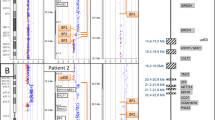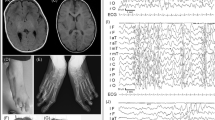Abstract
We report on a patient with a distal 16.4-Mb duplication at 2q36.3-qter, who presented with severe intellectual disability, microcephaly, brachycephaly, prominent forehead, hypertelorism, prominent eyes, thin upper lip, and progenia. Copy number analysis using whole exome data detected a distal 2q duplication. This is the first report describing a distal 2q duplication at the molecular level.
Similar content being viewed by others
Introduction
Partial 2q duplication is a very rare chromosomal abnormality possibly arising from parental chromosomal rearrangements also involving a deletion of another partner chromosome. Therefore, pure distal 2q duplication without another partner chromosomal rearrangement is an extremely rare condition and its etiologies have not been fully understood1,2,3,4. Here, we describe a patient with a distal 16.4-Mb duplication and discuss the genetic and clinical aspects.
Data report
The patient was the first child born normally to healthy non-consanguineous Japanese parents at 39 weeks of gestation. His family history was unremarkable. His birth weight was 2,708 g (21.2 centile). No fetal structural abnormality was detected by ultrasonography examination. At birth, no abnormality was pointed out. At the age of 10 months, the child was brought to our hospital because he could not sit alone. Brain magnetic resonance imaging showed a slightly small frontal lobe and brachycephaly, whereas myelinization of the nervous tissue was normal (Supplementary Fig. S1). He showed microcephaly of 44.2 cm (10th centile) at 14 months, brachycephaly, prominent forehead, hypertelorism, prominent eyes, thin upper lip, and progenia (Table 1). He showed normal developmental milestones, but he did not speak single words at 6 years. G-banded chromosome analysis of the patient and his parents was reported as normal.
The institutional review board of the Yokohama City University School of Medicine approved this study. Peripheral blood samples were collected from the patient and his parents after obtaining written informed consent. Genomic DNA extracted from blood leukocytes was used for the genetic analysis. Whole exome sequencing (WES) of the extracted DNA samples was performed on a HiSeq 2500 platform (Illumina, San Diego, CA, USA) with 101 bp paired-end reads. After quality control, the reads were aligned to the human reference genome (UCSC hg19, NCBI build 37.1, https://genome.ucsc.edu/) using NovoAlign (http://www.novocraft.com/products/novoalign/). The WES analysis procedure was as described previously5,6,7. Possible pathogenic variants were evaluated using SIFT (http://sift.jcvi.org/), PolyPhen2 (http://genetics.bwh.harvard.edu/pph2/), and MutationTaster (http://MutationTaster.org/). Possible pathogenic variants were confirmed by Sanger sequencing. Copy number variations (CNVs) were analyzed using the WES data with a slightly modified eXome Hidden Markov Model (XHMM) and Nord’s program based on relative depth of coverage ratios8,9. Candidate CNVs were validated by quantitative PCR (qPCR) at the selected spots as described previously5. Normalization was performed with an autosomal internal control locus (STXBP1 and/or FBN1). CNVs were compared among an unrelated control individual, the patient, and his parents. The PCR conditions and primer sequences are available on request.
Firstly, we performed WES of the patient’s DNA sample, but no pathogenic single-nucleotide variants (SNVs) were detected. The CNVs analysis using XHMM also did not detect any pathological CNVs. Subsequently, trio-based WES and CNVs analysis were performed using trio-WES data and XHMM, and a distal 2q duplication of 16.4-Mb was detected of the patient’s DNA sample (Fig. 1A). We analyzed the duplicated region using Nord’s method focusing on candidate genes within the 16.4-Mb region, and confirmed the duplication from IRS1 to RTP5 at 2q36.3-qter, which contained 134 protein coding genes (Fig. 1B and Supplementary Table S1). The qPCR analysis confirmed the duplication at IRS1, COL4A4, and KIF1A (Supplementary Fig. S2). We re-examined the result of G-banded chromosome analysis in the patient. However, we could not recognize a distal 2q duplication. This duplication has not been registered in the ClinGen database (https://www.clinicalgenome.org/) or the Database of Genomic Variants (http://dgv.tcag.ca/dgv/app/home) of normal controls.
A Distal 2q duplication detected by an eXome Hidden Markov Model. The dashed-line box indicates the distal 2p duplication. B Copy number variations analysis by Nord’s method. The red arrow indicates the duplicated region. Asterisks indicate the genes used for qPCR. The 134 protein cording genes in the duplicated region are listed in Supplementary Table S1.
We counted the paternal and maternal alleles aided by SNVs in the duplicated region (Supplementary Table S2). In the patient, maternal reads were counted as approximately twice the paternal reads, indicating that maternal duplication had occurred (Supplementary Table S2).
Discussion
In a previous study, 2q duplications were found to arise mostly from a parental chromosomal rearrangement associated with the deletion of a partner chromosomal segment10. Pure partial 2q duplication with no deletion of a different partner chromosomal segment is extremely rare. To our knowledge, only four cases with pure 2q35-qter at G-banded chromosome level have been reported1,2,3,4, but without any precise information of duplication regions at the molecular level.
In the four previous reported cases and in our patient, intellectual disability (5/5, 100%), brachycephaly (3/4, 75%), prominent forehead (5/5, 100%), broad nasal bridge (3/5, 60%), overhanging nasal tip (4/5, 80%), hypertelorism (3/5, 60%), ocular anomalies (3/5, 60%), thin upper lip (5/5, 100%), dental abnormalities (3/3, 100%), large ears (4/5, 80%), low set ears (3/5, 60%), clinodactyly of fifth finger (4/5, 80%), and genital anomalies (3/5, 60%) were relatively common (Table 1), suggesting these characteristics may be important clinical features of distal 2q duplication. Interestingly, in two male patients reported previously, genital abnormalities were recognized including shawl scrotum, hypospadias, and cryptorchidism1,3, but the case reported here had no genital anomaly (Table 1). The four previously reported cases were analyzed only at the chromosomal (not molecular) level, so it is possible that the inconsistent clinical features may be attributed to imprecise duplicated regions among them.
Our patient had an approximately 16.4-Mb 2q duplication at 2q36.3-37.3, a region that included at least 134 protein cording genes. Among them, variants in 26 genes are known to lead to Mendelian diseases, but no triplosensitivity (TS) gene (TS score of 2 or 3) was found, implying there was no strong contribution of a single gene in the distal 2q duplication (Supplementary Table S1).
WES data suggested that a duplication in this patient derived from maternal allele. In six heterozygous SNVs mapped to the duplicated region in the patient and mother, all maternally derived reads were counted as twice comparing the wild-type reads in the patient (Supplementary Table S2). If the duplication was derived from two maternal homologous chromosomes, variant reads should be half of wild-type reads in count. Therefore, these results indicated that its maternal duplication was derived from only a single homologous chromosome 2 in the mother. We could not determine whether the duplication is direct (tandem) or inverted or insertion of another chromosome.
In summary, we have described a distal 2q duplication in a patient at the molecular level for the first time. However, further evidence for its etiology is needed.
HGV database
The relevant data from this Data Report are hosted at the Human Genome Variation Database at https://doi.org/10.6084/m9.figshare.hgv.3240.
References
Dahoun-Hadorn, S. & Bretton-Chappuis, B. De novo inversion-duplication of 2q35-2qter without growth retardation. Ann. Genet. 35, 55–57 (1992).
Elbracht, M. et al. Pure distal trisomy 2q: a rare chromosomal abnormality with recognizable phenotype. Am. J. Med. Genet. A 149A, 2547–2550 (2009).
Fritz, B. et al. Trisomy 2q35-q37 due to insertion of 2q material into 17q25: clinical, cytogenetic, and molecular cytogenetic characterization. Am. J. Med. Genet. 87, 297–301 (1999).
Hermsen, M. A. et al. High resolution microarray CGH and MLPA analysis for improved genotype/phenotype evaluation of two childhood genetic disorder cases: ring chromosome 19 and partial duplication 2q. Eur. J. Med. Genet. 48, 310–318 (2005).
Aoi, H. et al. Whole exome sequencing of fetal structural anomalies detected by ultrasonography. J. Hum. Genet. 66, 499–507 (2021).
Uchiyama, Y. et al. Efficient detection of copy-number variations using exome data: Batch- and sex-based analyses. Hum. Mutat. 42, 50–65 (2021).
Suzuki, T. et al. A homozygous NOP14 variant is likely to cause recurrent pregnancy loss. J. Hum. Genet. 63, 425–430 (2018).
Nord, A. S., Lee, M., King, M. C. & Walsh, T. Accurate and exact CNV identification from targeted high-throughput sequence data. BMC Genomics 12, 184 (2011).
Miyatake, S. et al. Detecting copy-number variations in whole-exome sequencing data using the eXome Hidden Markov Model: an ‘exome-first’ approach. J. Hum. Genet. 60, 175–182 (2015).
Ronzoni, L. et al. Molecular cytogenetic characterization of a 2q35-q37 duplication and a 4q35.1-q35.2 deletion in two cousins: a genotype-phenotype analysis. Am. J. Med. Genet. A 167, 1551–1559 (2015).
Acknowledgements
We thank the patient and family for their participation in this study. We also thank N. Watanabe, T. Miyama, M. Sato, S. Sugimoto, and K. Takabe for their technical assistance. This work was supported by the Japan Agency for Medical Research and Development (AMED) (grant numbers JP22ek0109486, JP22ek0109549, and JP22ek0109348); JSPS Kakenhi (grant numbers JP19H03621, JP20K07907, JP20K08164, JP21K15907, JP21K07869, JP20K07907, and JP20K08164); and the Takeda Science Foundation. We thank Margaret Biswas, PhD, from Edanz (https://jp.edanz.com/) for editing a draft of this manuscript.
Author information
Authors and Affiliations
Corresponding author
Ethics declarations
Competing interests
The authors declare no competing interests.
Additional information
Publisher’s note Springer Nature remains neutral with regard to jurisdictional claims in published maps and institutional affiliations.
Supplementary information
Rights and permissions
Open Access This article is licensed under a Creative Commons Attribution 4.0 International License, which permits use, sharing, adaptation, distribution and reproduction in any medium or format, as long as you give appropriate credit to the original author(s) and the source, provide a link to the Creative Commons license, and indicate if changes were made. The images or other third party material in this article are included in the article’s Creative Commons license, unless indicated otherwise in a credit line to the material. If material is not included in the article’s Creative Commons license and your intended use is not permitted by statutory regulation or exceeds the permitted use, you will need to obtain permission directly from the copyright holder. To view a copy of this license, visit http://creativecommons.org/licenses/by/4.0/.
About this article
Cite this article
Suzuki, T., Osaka, H., Miyake, N. et al. Distal 2q duplication in a patient with intellectual disability. Hum Genome Var 9, 39 (2022). https://doi.org/10.1038/s41439-022-00215-8
Received:
Revised:
Accepted:
Published:
DOI: https://doi.org/10.1038/s41439-022-00215-8




